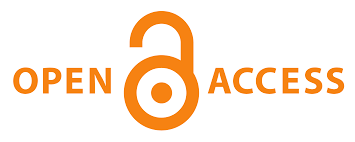Improving Students’ Learning Outcomes through Jigsaw Method: A Classroom Action Research at SMPN 8 Satap Woja
Main Article Content
Saidatul Kainati
This research is prompted by the issues that arise at SMPN 8 Satap Woja, specifically the fact that after the teacher integrates English learning on the teacher-suggested materials, student learning outcomes remain low. That is evident from both the teacher's observations and the students' learning outcomes that merely a small number of students are engaged in class. Student activity is important to the learning process because it influences learning outcomes. In addition, student interest and response have a significant impact on the achievement of learning outcomes during the learning process. As a result of being aware of the aforementioned issues, a teacher feels compelled to improve lessons by conducting research. This study is a classroom action research utilizing the Jigsaw method to enhance student learning outcomes for at SMPN 8 Satap Woja. This study has been conducted in two cycles. Based on the analysis of data in this study, Jigsaw research could indeed improve student learning outcomes. The implementation of the Jigsaw method model can increase student participation. The Jigsaw learning model can enhance student learning outcomes, as evidenced by the pre-test average of 47%, cycle 1: 58%, and cycle 2: 70.5%.
Ab Murat, N. B. (2008). Learning through teaching and sharing in the jigsaw classroom. Annals of Dentistry University of Malaya, 15(2), 71-76.
Adam, S. (2004). Using learning outcomes. In Report for United Kingdom Bologna Seminar (pp. 1-2). Edinburgh, UK: Heriot-Watt University (Edinburgh Conference Centre).
Al-Thani, S. J., Abdelmoneim, A., Daoud, K., Cherif, A., & Moukarzel, D. (2014). A perspective on student learning outcome assessment at Qatar University. Quality in Higher Education, 20(3), 255-271. DOI: https://doi.org/10.1080/13538322.2014.964079
Altrichter, H., Kemmis, S., McTaggart, R., & Zuber‐Skerritt, O. (2002). The concept of action research. The learning organization. DOI: https://doi.org/10.1108/09696470210428840
Aronson, E. (1978). The jigsaw classroom. SAGE.
Aronson, E. (2002). Building empathy, compassion, and achievement in the jigsaw classroom. In Improving academic achievement (pp. 209-225). Academic Press. DOI: https://doi.org/10.1016/B978-012064455-1/50013-0
Ayunigtyas, D.I. (2012). Politeness Strategy in Request: Does It Always Work Well? Prosodi: Jurnal Ilmu Bahasa dan Sastra, 6(2), 1-10. DOI: https://doi.org/10.21107/prosodi.v6i2.54
Bautista, A., Habib, M., Eng, A., & Bull, R. (2019). Purposeful play during learning centre time: From curriculum to practice. Journal of Curriculum Studies, 51(5), 715-736. DOI: https://doi.org/10.1080/00220272.2019.1611928
Blajvaz, B. K., Bogdanović, I. Z., Jovanović, T. S., Stanisavljević, J. D., & Pavkov-Hrvojević, M. V. (2022). The Jigsaw Technique in Lower Secondary Physics Education: Students’ Achievement, Metacognition and Motivation. Journal of Baltic Science Education, 21(4), 545-557.
Erikson, M. G., & Erikson, M. (2019). Learning outcomes and critical thinking–good intentions in conflict. Studies in Higher Education, 44(12), 2293-2303. DOI: https://doi.org/10.1080/03075079.2018.1486813
Falchikov, N., & Goldfinch, J. (2000). Student peer assessment in higher education: A meta-analysis comparing peer and teacher marks. Review of educational research, 70(3), 287-322. DOI: https://doi.org/10.3102/00346543070003287
Hussey, T., & Smith, P. (2003). The uses of learning outcomes. Teaching in higher education, 8(3), 357-368. DOI: https://doi.org/10.1080/13562510309399
Khamroev, A. (2021). Quality and effectiveness for design of learning outcomes in the language teaching. Academicia: An International Multidisciplinary Research Journal, 11(1), 549-558. DOI: 10.5958/2249-7137.2021.00085.9
Kostoulas, A., Babić, S., Glettler, C., Karner, A., Mercer, S., & Seidl, E. (2019). Lost in research: educators’ attitudes towards research and professional development. Teacher Development, 23(3), 307-324. DOI: https://doi.org/10.1080/13664530.2019.1614655
Lian, B., Kristiawan, M., Primasari, D. A. G., & Prasetyo, M. A. M. (2020). Teachers’ model in building students’ character. Journal of Critical Reviews, 7(14), 927-932. DOI: http://dx.doi.org/10.31838/jcr.07.14.165
Muntasir, M., Rahman, F., & Haekal, M. (2022). THE EFFECTS OF CORRECTIVE FEEDBACK ON FLUENCY AND ACCURACY IN 4/3/2 ACTIVITY: A CASE OF STUDENTS AT ELTO SPELL-OUT PROGRAM. Elite: English and Literature Journal, 9(1), 42-54. DOI: https://doi.org/10.24252/elite.v9i1.26526
Nalls, A. J., & Wickerd, G. (2022). The Jigsaw Method: Reviving a Powerful Positive Intervention. Journal of Applied School Psychology, 1-17. DOI: https://doi.org/10.1080/15377903.2022.2124570
Premalatha, K. (2019). Course and program outcomes assessment methods in outcome-based education: A review. Journal of Education, 199(3), 111-127. DOI: https://doi.org/10.1177/0022057419854351
Rahmah, S., & Ilham, M. (2022). Management of Students’ Religious Culture. Development: Studies in Educational Management and Leadership, 1(1), 39–54. DOI: https://doi.org/10.47766/development.v1i1.644
Rahman, F., & Yuzar, E. (2020). Students' Perception towards NNESTs & NESTs' Teaching Styles: A Study at State Islamic University of Ar-Raniry. Indonesian Journal of English Language Teaching and Applied Linguistics, 4(2), 321-335. DOI: http://dx.doi.org/10.21093/ijeltal/v4i2.516
Saputra, N., & Muntasir, M. (2021). The Integration of Mind Mapping Technique in Storytelling to Assist EFL students in Mastering Speaking Skill. International Journal of Education, Language, and Religion, 3(2), 49-54. DOI: https://doi.org/10.35308/ijelr.v3i2.4460
Sari, M. P., Putri, N. H., Zahriana, E., & Safwan, M. (2022). Picture and Picture Learning Model to Improve Students’ Achievement in Writing Recount Text. JETLEE: Journal of English Language Teaching, Linguistics, and Literature, 2(1). DOI: https://doi.org/10.47766/jetlee.v2i1.251
Seechaliao, T. (2017). Instructional strategies to support creativity and innovation in education. Journal of education and learning, 6(4), 201-208. DOI: http://doi.org/10.5539/jel.v6n4p201
Van Alten, D. C., Phielix, C., Janssen, J., & Kester, L. (2019). Effects of flipping the classroom on learning outcomes and satisfaction: A meta-analysis. Educational Research Review, 28, 100281. DOI: https://doi.org/10.1016/j.edurev.2019.05.003
Yuliza, Y. (2022). Education Planning Curriculum Based on Technology: Impact Evaluation. Development: Studies in Educational Management and Leadership, 1(1), 55–74. DOI: https://doi.org/10.47766/development.v1i1.642
Yusridawati, Y. (2022). Improving Students’ Speaking Ability Through Demonstration Method:(A Case Study of Junior High School Students). JETLEE: Journal of English Language Teaching, Linguistics, and Literature, 2(1). DOI: https://doi.org/10.47766/jetlee.v2i1.211
Yuzar, E. (2022). Classroom Evaluation: Learners’ Perspectives on The Teaching Approach in A Second Language Writing Course. JETLEE: Journal of English Language Teaching, Linguistics, and Literature, 2(2). DOI: https://doi.org/10.47766/jetlee.v2i2.484




